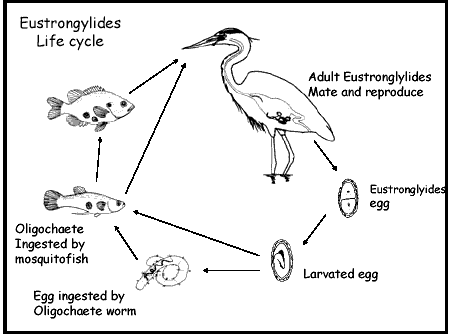Parasites and Seafood
Getting a panicked call from a patient at 6:00 a.m. is uncommon, and always concerning. Debbie was a brilliant, talented designer whose designs were sought after by the élite of Arizona. I had known her through a number of philanthropic causes that we were both involved in. In meetings she was the person who never lost her cool, always had something interesting to say, and never felt inclined to talk just to hear herself.
On this particular morning, this articulate individual could not form a single sentence beyond that she was dying inside. After I asked her to take three deep breaths, she managed to tell me that there was an alien inside of her, and it was eating her.
Mental illness typically manifests itself in the late teens and early twenties. It is rare that this person I had known for a number of years would have some yet undefined illness. I never saw her imbibe at parties, she was a responsible mother, and I knew she was not taking any medications for mental illness, as I had removed her gallbladder a couple of years before. These are the thoughts one has at six o’clock in the morning.
After the three breaths she said that in the toilet was a large worm that had come out of her, and now she was convinced that they were eating her alive. I asked if she had a fear of spiders. She said yes; they would turn her into a blabbering, spastic person who would run wildly away.
Her husband was away, but she managed to get her son to put the creature into a plastic bag that she would bring to my office. Her son, in contrast to her mom, thought it was “cool.”
When I saw her in my office an hour later, she was calm, collected, and apologizing for “being a raving lunatic.” Her son proudly showed me the catch. What boy doesn’t like intestinal worms? Most doctors’ favorite college biology courses were about worms and parasites—worms have fascinating life cycles and are kind of creepy, but they’re generally harmless.

The Tapeworm
In this case the worm was Diphyllobothrium latum, commonly called the broad tapeworm. Debbie’s was eight inches long, but they have been reported to grow up to thirty feet long (one can imagine the scene in that bathroom). When I told Debbie that the answer was a single pill called Praziquantel, she looked stunned.
“I had called my husband,” she said, “and told him you would probably have to do emergency surgery to get all the worms out of my guts, and he was going to head back from New York to be with me.”
At that moment I dialed her husband, who had yet to make plans to interrupt his business trip. He was happy that his wife was okay, and he said, “Normally Deb is one of the most even-keeled people I know.” He enjoyed a good laugh before begging me not to tell her that he laughed.
This flatworm comes from eating raw or under cooked fish. They can be found in salmon, trout, perch, walleyed pike, and, in Debbie’s case, from uncooked gefilte fish. As it‘s being made, the cook tastes the raw samples to make certain the spices and seasonings are perfect.

Instead of buying commercial, some make their own Gefilte Fish- but tasting raw fish to check seasonings can lead to parasitic infection
Debbie wanted to blame her favorite sushi restaurant. It’s unlikely; the US Food and Drug Administration requires that fish, if it is to be eaten raw, first must be frozen to kill parasites. Tuna is the only exception to this rule, although tuna is often frozen in order to transport it for the worldwide love of this product.
Freezing kills parasites, but not bacteria. Home refrigeration units are often not cool enough, unless they can maintain a temperature of -4 degrees F for seven days. Most recommendations are to freeze in the commercial freezers at -31 degrees F for 15 hours, or freezing to -31 degrees then storing at -4 degrees F for a minimum of 24 hours.
Dry ice is available to most home cooks, and keeping the fish in dry ice for a day will allow them to be frozen solid well below concerning points. Dry ice should be kept in a container, not in the home freezer, as it will shut off the freezer due to extreme cold. (If your freezer stopped working because of power interruption, dry ice will keep your food frozen. Dry ice sublimates about five to ten pounds per day, and keeps a temperature of between 110 and 78 degrees below zero.)
Cooking will eliminate most parasites at time and temperatures of low-temperature cooking. Pasteurization can occur at 130 degrees for 112 minutes or 140 degrees for eleven minutes. Since most fish is best served at 125 degrees, pre-treatment with freezing is preferred.
Tapeworms – Diphyllobothrium Species
There are fourteen species of tapeworms that are intestinal parasites. Patients like Debbie become aware of them typically by finding bits of worm in their stool. Records have not been kept of these worms since the 1980s, but at that time up to two hundred cases a year were reported. All were from eating raw or undercooked fish dishes including sushi, sashimi, ceviche, crudo, and tartar, or tasting raw fish before cooked (gefilte fish). They are found in fresh and saltwater fish. If there was ever a reason to freeze fish, these worms are it. They’re found in Pacific salmon, but also freshwater fish like Alaska blackfish, Dolly Varden, char, burbot, walleye, perch, and pike.
These worms live peacefully in the intestine but absorb vitamin B12, and some people have presented with severe anemia. Part of the work up of anemia is endoscopy, and while looking through the colonoscope having a worm look back at you is an interesting experience.
An outbreak occurred in 1980 among physicians who had consumed sushi from raw salmon in Los Angeles. The irony of this is left to the imagination of the reader.
Paragonimus
This is a parasitic fluke, or flatworm, that has been implicated with eating infected crab or crawfish. The infected crustaceans are often from eating raw crayfish on raft trips, but could also be from partially cooked, salted, or pickled crawfish. The larva of the parasite is released in the stomach and they migrate throughout the body, often into the lungs six to ten weeks later. The initial symptoms are two to fifteen days after ingestion with diarrhea and abdominal pain, then progressing to a dry cough which becomes productive with rust-colored or blood tinged sputum. It’s often mistaken for tuberculosis. Diagnosis can be seen on the sputum sample. If the fluke travels to the brain, it can cause severe meningitis and death. Fresh water crayfish should not be simply steamed, but cooked at 145 degrees for a minimum of thirty minutes.
Roundworms, Anisakis simplex (called the herring worm) and Pseudoterranova (Phocanema, Terranova) decipiens (cod or seal worm).
These worms are found frequently in the flesh and organs of almost all ocean fish, but especially in cod, haddock, fluke, Pacific salmon, herring, flounder, monkfish, and squid.
The majority of infections come from A. simplex, but these worms (and a few others) are a complex of worms that can really only be told apart by DNA analysis. They have complex lifecycles going from eggs that form larvae, and are ingested by crustaceans, where they become mature larvae. Squid and other fish eat the crustaceans, and humans who have not cooked or frozen the seafood eat the fish.
Some people experience a tingling sensation after or while eating raw or undercooked fish or squid, which is the worm moving in the mouth or throat. Some people then extract the worm manually from their mouth or cough up the worm. Also, some people experience vomiting as a symptom, and this can often expel the worm from the body. Symptoms are typically nausea, vomiting, abdominal distention, but the person can have an allergic reaction with rash and itching. Diagnosis is made using endoscopy to look in the stomach, and simple extraction by the scope will cure the patient. Rarely surgery is required (although when we see those worms it is pretty neat), but they have caused blockage of the small bowel, requiring surgery, and have been the cause of appendicitis. The worm only survives for about three weeks in people before it dies and is excreted. The person suffers from pain because the worm elicits an inflammatory response that is painful. After these worms were first recognized in the 1960s there were about ten cases reported annually in the United States. In Japan, where sushi is not frozen there are about a thousand cases reported yearly.
Other Species
There have been five cases of Eustrongylides species, of which four were fishermen who ate live minnows (the fishing must not have been very good that day). In twenty-four hours the worms work into the bowel, and in four of the cases surgery was required.

There have been twenty-three cases of Nanophyetus salmincola, a worm found in the freshwater phase of a salmon’s life, particularly in the Pacific Northwest. Symptoms occur with the typical abdominal discomfort, diarrhea, nausea, and vomiting, and a week after ingestion there are eggs that will appear in the stool.

Salmon should be cooked, or frozen solid before eating raw
No doubt there are a number of these types of worms waiting to be discovered. If you wish to avoid being the subject of discovery of these or a new species, appropriate freezing or cooking of fish is all that is needed.
